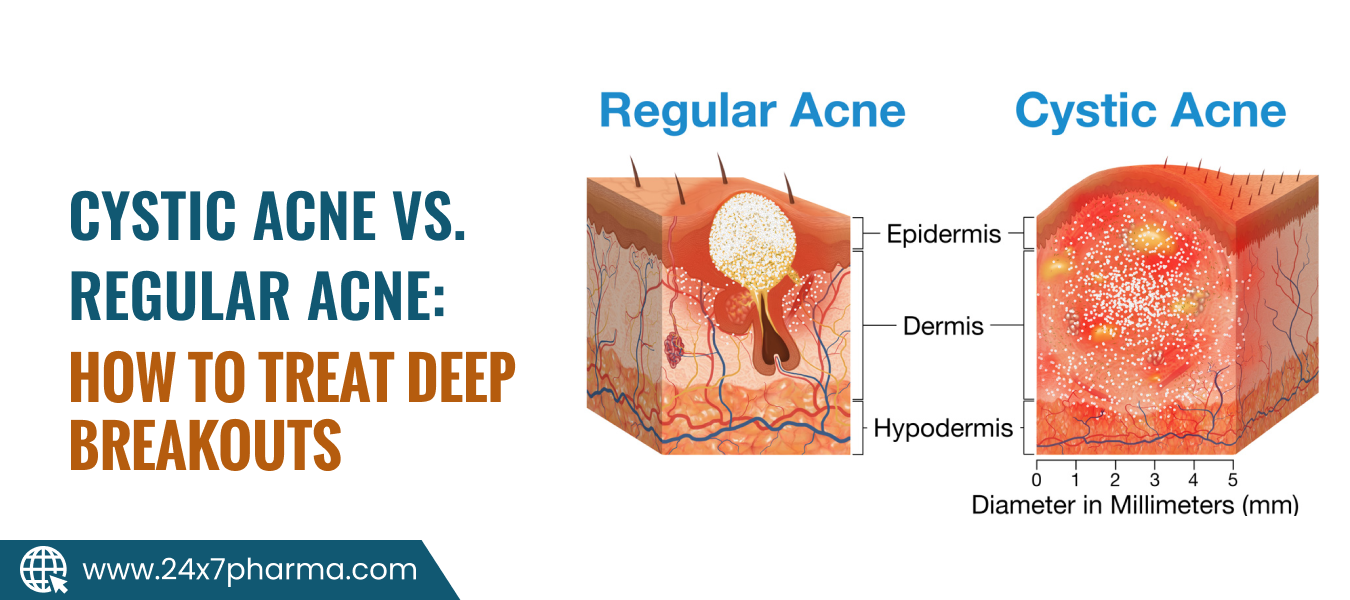Not All Pimples Are Created Equal
Let’s be real—most of us have faced a surprise pimple before a big event. But when a breakout starts to feel like it’s brewing beneath the surface and sticking around for weeks, you’re not just dealing with regular acne anymore.
Cystic acne isn’t just a “bad breakout.” It’s a whole different ball game—and treating it with regular drugstore products might not cut it. So, what’s the difference between cystic acne vs. regular acne? And more importantly, how do you treat them?
Let’s break it down.
What Is Regular Acne, Really?
Regular acne—also known as acne vulgaris—includes your run-of-the-mill whiteheads, blackheads, and those tiny red bumps that sometimes show up after eating greasy food or sweating at the gym.
Common triggers include:
- Excess oil production
- Clogged pores
- Bacteria (P. acnes)
- Hormonal fluctuations
These breakouts usually sit close to the surface of the skin. While annoying, they’re often easier to treat and respond well to over-the-counter products like benzoyl peroxide or salicylic acid. In most cases, they clear up in a week or two.
Now Enter: Cystic Acne, the Drama Queen of Skin Woes
If regular acne is like a fire alarm, cystic acne is a five-alarm blaze.
Cystic acne forms deep underneath the skin and results in large, inflamed, and often painful lumps. These breakouts don’t usually come to a head and can stick around for weeks—or even months.
What causes cystic acne?
- Hormonal shifts (especially around periods or puberty)
- High-sugar or high-dairy diets
- Genetics (yup, you can thank your DNA)
- Stress (your skin feels those cortisol levels)
These breakouts are harder to treat because the inflammation is happening deep within your skin—meaning surface-level treatments won’t do much. And unfortunately, cystic acne is much more likely to leave behind acne scars.
Read More : The Ultimate Acne Guide: Causes, Treatments & Prevention
Spot the Difference: Cystic vs. Regular Acne
Let’s break it down real quick:
| Feature | Regular Acne | Cystic Acne |
| Depth | Surface | Deep under the skin |
| Pain | Mild or none | Often painful |
| Appearance | Whiteheads, blackheads | Swollen, red, no “head” |
| Treatment | OTC products | Prescription needed |
| Risk of Scars | Low | High |
Still not sure which one you’ve got? If your breakout feels sore to the touch and doesn’t respond to your usual spot treatment, chances are it’s cystic.
How to Treat Regular Acne (The Right Way)
The good news? Regular acne is totally manageable with the right routine.
Try this simple skincare flow:
- Cleanse: Use a gentle foaming cleanser with salicylic acid.
- Treat: Apply a benzoyl peroxide spot treatment or adapalene (a type of retinoid).
- Moisturize: Don’t skip this—hydrated skin heals faster!
- Protect: Always use SPF, even if you have oily skin.
Stick with your routine for at least 6–8 weeks before switching products. Acne takes time to heal—and jumping from product to product won’t help.
How to Treat Cystic Acne (Deep Breakouts Need Deep Care)
Here’s the truth bomb: You can’t treat cystic acne with just drugstore face washes. You’ll need medical-grade help to get real results.
Best treatments for cystic acne:
- Oral antibiotics – Reduce inflammation and bacteria.
- Hormonal therapy – Like birth control or spironolactone.
- Isotretinoin (Accutane) – For severe, chronic cases.
- Cortisone injections – Fast-acting treatment from your derm.
Support your treatment with a calming skincare routine:
- No harsh scrubs
- Use fragrance-free, non-comedogenic products
- Try niacinamide for inflammation and barrier repair
What NOT to Do (Seriously, Please Don’t)
❌ Don’t pop it – especially cystic acne. It’ll just make things worse.
❌ Don’t over-exfoliate – you’ll damage your skin barrier.
❌ Don’t skip sunscreen – UV damage + acne = scar city.
❌ Don’t freak out – healing takes time.
Final Thoughts: It’s Not Just Acne—It’s Your Skin Story
So here’s the deal: knowing the difference between cystic acne vs. regular acne is half the battle. The other half? Being patient, consistent, and kind to your skin.
Treating cystic acne takes time and the right tools, but with the right routine and possibly a dermatologist’s help, clearer skin is possible.
You got this. Your skin isn’t the enemy—it just needs a little support.

